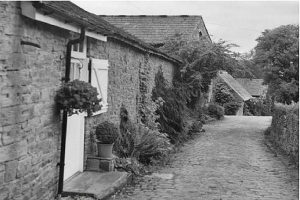 |
William Clayton bought the Endon estate (which included the quarries) from the Wettons who were local quarry owners and stone merchants, (see sample bill below). Prior to 1875 Clayton initially called the Hall, as we know it, Endon House (not Hall). He built the hall together with Turret Cottages and Clayton’s Tower on Windmill Lane which was then called Township Road. The tower appears to have been built as a folly, no practical use having been found for it. He built Endon Hall for himself and Endon House for his manager Williamson. Find further information on the Kerridge page. 
|

|
The stables and coach house |
|
1891: John Charlton aged fifty six years and from Salford lived at Endon Hall, he was a Cotton Linen worker and woollen cloth finisher. His wife Henrietta aged forty two years was from Liverpool and their six children all born in Salford age range nine to nineteen years also lived there. There were eight servants. 1892: According to Kelly’s 1892 directory Arthur S. Plews lived at Endon Hall. In 1897 his wife Francis M. Plews laid the foundation stone for Holy Trinity chapel in Jackson Lane. 1901: Frances M. Plews was still living at Endon Hall, she was aged forty two years and was described as living off her own means. She was married but there is no mention of her husband Arthur S. Plews who is listed as living there in 1892. However, by 1906 the Kelly’s directory once again lists Arthur as living at Endon Hall. Frances was from Audlem and lived with her daughter aged four years and also four servants. Peter Pownall Brocklehurst had connections with Endon Hall around this time as stated on the 1902 Electoral Roll although he was actually living at Hurdsfield House at that time. Perhaps he owned Endon Hall. 1911: John E. Galgani was living at Endon Hall.He had moved to 18 Higher Lane by the following year. He had been living at Endon Lodge ten years previously. 1914: Endon Hall was occupied by James Edward Marsland and his family. They were still there in 1923 according to Kelly’s directories. 1939: The Hall was occupied by Harold Kershaw aged fifty seven years, he was a solicitor. Also living with him was his wife Pleasance aged fifty two years and their son Peter aged twenty four years and described as a brewer. Mr Cosgrove also lived at Endon Hall around the time of the second world war. The Kershaw’s were at Endon Hall until the 1960’s. Mr and Mrs Ramsden lived at Endon Hall in more recent years and were both doctors. Mossleys Tyre manufacturer also once owned Endon Hall before it was sold and split into two residences. In July 2006 Macclesfield Borough Council varied the boundary of the Bollington and Kerridge conservation area. The purpose was to include additional properties within the conservation area. These properties included Endon Hall North, South, and West, Endon Hall Farmhouse, Endon Hall Farm, 1, 2 and 3 Endon Hall Mews, the property having been by this time divided up into multi-occupancy. Also added to the Conservation Area were 4, 6 and 8 Windmill Lane. |
||||||
  |
||||||
|
 |
Stables at Endon Hall, Kerridge |
|
| Icehouse in Endon Hall garden, Kerridge |
Acknowledgements
- The historical information on this page about the construction of the house is taken from the Historic England
 website.
website. - thre’penny piece or thrupnee-bit – a three penny, twelve sided, coin
 used in the UK until decimal currency was introduced in 1971.
used in the UK until decimal currency was introduced in 1971. - Our thanks go to Linda Stewart who has researched census information to present an interesting history of the house’s residents.
Your Historic Documents
Please don't chuck out those historic documents and pictures! Find out why here.
